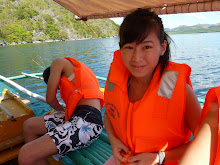As promised, this is the write up by my friend, Desmond Lim featured in THE STRAITS TIMES SATURDAY, OCTOBER 10 2009 PAGEs D8 and D9. Do the class assignment that was tasked to you in my previous blog entry....
Love Miss Tan
Journalists help isolated villagers get aid by highlighting their plight
- By Photojournalist, Desmond Lim
PADANG PARIAMAN (West Sumatra): On Wednesday, I had a taste of what it must feel like to be buried alive.
As I was treading gingerly through the muddy swamp of the landslide area where villages once stood, I sank waistdeep into soft mud.
I was totally immobilised, with my cameras held aloft. Each time I tried pushing myself out of the mud, I went deeper into it. I shouted for help and two Indonesian rescue workers saw me and pulled me to safety.
When I was finally on firmer ground, I stared at my trousers coated with mud. That was when, for the first time in a week, the thought struck me: What am I doing here?
For five days, I had gone without a shower, no permanent shelter to stay in, no supply of clean water and almost no food. I had trekked up and down mountains, waded through a soggy rice field and crossed a wafer-thin makeshift bamboo bridge and then made my way back.
I am not complaining. It was just that, at that moment in the mud, I found myself pausing to ponder hard over my work. When the 7.6-magnitude earthquake struck in West Sumatra last Wednesday, I was among a batch of journalists jostling at the airport for the first flight into Padang.
When the first flight on Thursday morning was cancelled, the journalists lost not only their seats but also their tempers.
Everyone scrambled to find a way in, some even contemplating a flight to Medan, followed by a 12-hour drive to Padang. All of us wanted to be there first to get the stories and pictures out.
After several attempts to get there, I finally landed at Padang airport at 8pm last Thursday. My editors texted me a message: “Singaporean rescued from hotel.” I knew I had to get to him. The city was in complete darkness due to the power cut.
Armed with my camera equipment, a laptop and my luggage, I teamed up with a German journalist to catch a taxi and look for a hospital.
One of the hospital’s buildings had collapsed. The ceiling in the main building had caved in and its corridors were packed. People were wailing and groaning in pain. Children were crying. Used syringes were strewn all over the place. The stench of dried blood and urine almost knocked me over.
Over the next hour, I gesticulated and spoke the little Malay that I knew to the hospital staff there to try to locate the Singaporean survivor. I finally found him on an old rusty gurney in the corner of the A&E department.
After I identified myself and interviewed him, he asked me in a feeble voice to pass a message to his family back in Singapore to tell them that he was safe, which I did.
He was grateful, his family was relieved and I was glad to be the bearer of good news. He put his hand gently on my arm and thanked me. In that second, the stress I had gone through the last 24 hours was worth it.
When I headed to the villages in Padang Pariaman, another quake-affected area with almost no aid, last Saturday, the huge cameras on both my shoulders made it clear I was a photojournalist. Before long, a mob of villagers had gathered around me, earnestly begging me to photograph what was left of their houses.
A colleague proficient in Bahasa Indonesia told me that the villagers wanted the photographs to be published so that help would come to them. They were pleading with me for their stories to be told.
Just three days later, I had to photograph a 52-year-old villager, Mr Ali Abuzar, who lost four children in the landslide that buried his entire village in Padang Pariaman.
As I snapped away at the scene before me, he knelt on the ground where his house once stood and wept. Later, I learnt that it was his first visit back to the village since the ground rumbled and raged.
Remembering how difficult it was for me to pull myself out after sinking waistdeep in mud at the village that is now a mass grave, I cannot help but think how hopeless it was for those buried alive. How can anyone crawl out from under 6m of mud?
I looked at him, snapped a few frames and stopped shooting. Why was I intruding on what must be his moment of unimaginable grief?
Six days later, aid is still trickling into the remote areas. I learnt from other journalists that more supplies will be ferried to other remote areas as agencies learn about the plight of isolated villagers from the media.
I found my own answer to that question of why journalists go to these places.
We go, so that others will know.




Thanks for Sharing ! ^^
ReplyDelete